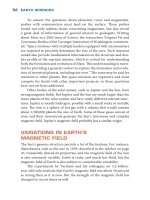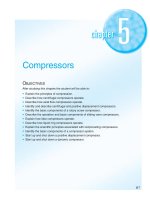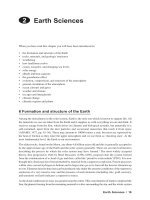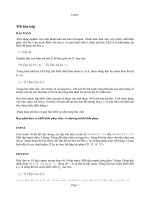- Trang chủ >>
- Khoa Học Tự Nhiên >>
- Vật lý
5 6 hurricanes (earth sciences)
Bạn đang xem bản rút gọn của tài liệu. Xem và tải ngay bản đầy đủ của tài liệu tại đây (2.75 MB, 10 trang )
Genre
Nonfiction
Comprehension Skill
Draw Conclusions
Text Features
•
•
•
•
Captions
Labels
Diagrams
Glossary
Science Content
Weather
Scott Foresman Science 5.6
ISBN 0-328-23469-9
ì<(sk$m)=cdegjb< +^-Ä-U-Ä-U
Vocabulary
Extended Vocabulary
air mass
anemometer
atmospheric pressure
barometer
convection current
cyclone
front
rain gauge
tempered
wind
landfall
lull
NOAA
spiral pattern
torrential
tropical depression
tropical disturbance
wall clouds
Picture Credits
Every effort has been made to secure permission and provide appropriate credit for photographic material.
The publisher deeply regrets any omission and pledges to correct errors called to its attention in subsequent editions.
Photo locators denoted as follows: Top (T), Center (C), Bottom (B), Left (L), Right (R), Background (Bkgd).
Opener: The Science Museum/©DK Images;1 ©Bettmann/Corbis; 4 (B, BR) Getty Images; 5 (BR) The Cinema Museum/
Ronald Grant Archive; 6 (TL) ©Bettmann/Corbis, (BL) The Science Museum/©DK Images, (T) Schenectady Museum/
Hall of Electrical History Foundation/Corbis, (CR) Brand X Pictures; 8 (TL) ©Bettmann/Corbis, (B) Science Museum,
London/DK Images; 9 (TR) ©Alfred Pasieka/Photo Researchers, Inc.; 10 (TL) ©Bettmann/Corbis; 11 (CR) Reuters/Corbis;
12 (TL) ©Bettmann/Corbis, (B) Science Source/Photo Researchers, Inc.; 14 (TL) Hulton-Deutsch Collection/Corbis.
Unless otherwise acknowledged, all photographs are the copyright © of Dorling Kindersley, a division of Pearson.
ISBN: 0-328-23469-9
Copyright © Pearson Education, Inc. All Rights Reserved. Printed in the United States of America.
This publication is protected by Copyright, and permission should be obtained from the publisher prior to any
prohibited reproduction, storage in a retrieval system, or transmission in any form by any means, electronic,
mechanical, photocopying, recording, or likewise. For information regarding permission(s), write to
Permissions Department, Scott Foresman, 1900 East Lake Avenue, Glenview, Illinois 60025.
1 2 3 4 5 6 7 8 9 10 V010 13 12 11 10 09 08 07 06
by Peggy Bresnick Kendler
What You Already Know
The atmosphere is the air surrounding Earth. Atmospheric
pressure is the weight of air pushing down on an area.
Atmospheric pressure is greatest at Earth’s surface where there
is the most air above to push down. Pressure decreases as you
go up in the atmosphere and decreases as you go down.
You cannot see air, but it has mass and takes up space.
Earth’s gravity gives it weight. The weight of Earth’s air causes
air pressure.
Cool air is heavier than the same volume of warm air. The
air above the oceans is tempered, or warmed in the winter and
cooled in the summer. Temperature differences between cool air
and warm air cause convection currents.
A convection current is the rising and sinking of matter in a
circular pattern. Convection currents make wind, which is the
movement of air. Convection currents are also found in ocean
water and in rock deep beneath Earth’s surface.
An air mass is a large body of air. A front is a boundary
between two air masses. Sometimes when high-pressure air
surrounds low-pressure air, a wind called a cyclone starts flowing
in a circular path inward around the low-pressure air.
2
Cyclones, which cause fronts to move, also cause
severe weather, including thunderstorms, hurricanes, and
tornadoes. Severe weather also includes blizzards and
monsoons. A monsoon is a wind that changes directions
with the seasons.
A barometer shows air pressure and an
anemometer measures wind speed. A rain
gauge measures how much rain has fallen.
Weather forecasters use these tools, along
with weather balloons, satellites, radar,
and computer models, to predict the
weather days, weeks, months, or
even years in advance.
Hurricanes and tornadoes are
both strong storms. Tornadoes
have faster winds than
hurricanes have. Hurricanes
are bigger than tornadoes, and
they last longer. Keep reading to
learn more about hurricanes.
3
What are hurricanes?
Hurricanes are very large tropical
storms that form over warm water.
Hurricanes, typhoons, and cyclones are
all different names for the same type
of storm. In the western Pacific Ocean,
hurricanes are called typhoons. In the
Indian Ocean, they are called cyclones.
In the Atlantic Ocean, they are called
hurricanes.
Hurricanes have winds that have
reached a constant speed of at least 119
kilometers per hour. These winds blow
in a spiral pattern around a calm center
area called the eye.
satellite image of a hurricane
The eye of a hurricane is
usually between thirty and sixty
kilometers wide. The storm
can bring heavy rains, powerful
winds, and storm surges. A single
hurricane can spend more than
two weeks over open water.
Hurricane season in the
western North Atlantic is from
June 1 through November 30,
when the water is warmest. Most
Atlantic hurricanes form in August
and September. Hurricane season
in the eastern North Pacific is from
May 15 through November 30.
However, the Pacific Coast of the
United States rarely gets hit by
a hurricane.
Storm Names
All tropical storms are
given male or female
names. The names help
meteorologists identify
and track storms—
especially when more
than one happens at
the same time.
The strong winds of a hurricane
can knock over trees.
4
5
How Hurricanes Form
Hurricanes start as small thunderstorms over warm, tropical
oceans. They begin over a warm layer of water at the top of the
sea. This layer has a surface temperature of at least 26.5˚ Celsius,
or 80˚ Fahrenheit. The warm seawater is absorbed by the air. This
moist, warm air affects the atmospheric pressure. Atmospheric
pressure is the pressure caused by the weight of air.
The map shows the
places where severe
storms are most likely.
Most hurricanes in North America happen where different
water currents meet. Under certain conditions these currents
produce a group of thunderstorms called a tropical disturbance.
The disturbance grows as warm, moist air moves upward. As the
air rises, it cools and the water in it condenses and releases heat.
This causes lower atmospheric pressure, which pulls even more
air into the system.
As the wind moves faster, the tropical disturbance becomes
a tropical depression. As air moves into it, the system begins to
spin around. When the storm’s winds grow to 62 kilometers per
hour or greater, it becomes a tropical storm, and it is given a
name. If the storm keeps growing and its wind speeds reach 119
kilometers per hour, it becomes a hurricane.
Hurricane Mitch 1998
October 22, 1998: A storm
begins to form over the
Atlantic Ocean.
6
October 25, 1998: As the storm
develops into a hurricane, the
eye becomes visible.
October 26, 1998: Hurricane
Mitch becomes larger and
more powerful.
October 28, 1998: After it
reaches land, Hurricane Mitch
loses strength.
7
Inside a Hurricane
At Earth’s surface, the air pressure in a hurricane is
low. When the air moves from areas of high pressure to
areas of low pressure, strong winds develop. The warm,
moist air from the ocean moves to areas of low pressure.
There the air rises and forms bands of rain. These rain
bands can produce more than five centimeters of rain
per hour.
The powerful winds of a hurricane swirl around the
eye of the storm. A hurricane’s eye is calm. Within the
eye, there are few winds or clouds.
hurricane structure
fastest winds spiral
around eyewall
spiraling bands
of wind and rain
8
Storm clouds called wall clouds surround the eye
to form the eyewall. A hurricane’s strongest winds and
heaviest rains happen within wall clouds that spin around
the eye. In the eyewall, warm air spirals upward, causing
the most powerful winds of the storm.
9
Storm Damage
When a hurricane strikes land, we say it has made landfall.
As the hurricane moves over land, powerful winds and heavy
rains can remain over an area for several hours. Its raging winds
can reach a speed of more than 250 kilometers per hour. The
winds and rains can do tremendous damage. Hurricane winds
can rip trees out of the ground, tear the roofs off buildings, and
shatter windows. The torrential rains can cause heavy flooding.
10
As the hurricane’s eye passes over an area, the winds slow
and the sky might clear. There is a lull, or a brief calm, in the
storm. When the lull passes, the intense winds and heavy rains
resume. This is because the most powerful winds of the storm
surround the hurricane’s eye.
Hurricanes weaken as they move over land. They need
energy from the warm sea air to stay powerful.
This destruction was
caused by Hurricane
Frances, which battered
Florida in 2004.
11
Storm Surge
A hurricane can cause storm surges. A storm surge occurs
when the hurricane pushes ocean water onto the shore. During
a hurricane, ocean water is pulled up into the eye. This makes
enormous waves that gain even more power from the strong
hurricane winds. The result is a wall of seawater that crashes
onto land.
Some of the worst damage from a hurricane is caused by
storm surges. They are especially dangerous in areas where the
coast is at almost the same level as the ocean. During a storm
surge, ocean water pours onto land with tremendous force,
flooding streets and buildings. Buildings on hills are not as likely
to flood, but they are sometimes damaged by mudslides that
result from the heavy rain.
Besides flooding coastal areas, storm surges can do plenty
of damage to property. Rapid rises in sea level can damage
or destroy portions of bridges. Storm surges also can lift large
boats, wrecking them as they wash up on the shore or even
onto roads. Storm surges can also
be very dangerous for animals
and people who get caught in
the rushing water.
Waves pounded the island
of Bermuda as a hurricane
struck in 2003.
Storm surges form when
ocean water is pulled into
the hurricane’s eye.
When Hurricane Frances
struck Florida in 2004, some
boats were washed inland.
12
13
Monitoring Storms
Predicting and tracking hurricanes are important jobs of
weather forecasters and meteorologists. They alert people to
the growing storm. People in areas where the hurricane might
strike have time to prepare for the storm.
Weather forecasters use images from satellites to help them
follow a hurricane’s development over the ocean. The images
help them track a hurricane’s progress and its path. This way,
the forecasters can have a good idea where the storm will
make landfall.
The National Oceanic and Atmospheric Administration,
known as NOAA, sends specially equipped planes to fly right
into the center of hurricanes. The planes carry meteorological
equipment that gathers data inside the storms. The data are
fed into computer models that help forecasters make accurate
predictions during a hurricane. Data also help researchers
better understand what goes on inside storms and hurricanes.
This information helps meteorologists to be better hurricane
forecasters.
Meteorologists study
satellite images to help
them understand and
predict hurricanes.
14
A weather-research plane flies
into the eye of a hurricane to
gather information and monitor
the storm.
Devices on the weather-research planes measure air
pressure, humidity, temperature, and wind direction and speed.
This gives scientists a good idea of the structure and intensity
of the storm.
Hurricanes are very powerful storms. They can cause
great damage when they reach land. Their strong winds and
heavy rains can destroy anything in their path. Scientists study
hurricanes so they can learn as much as possible about these
dangerous storms.
15
Glossary
What did you learn?
1. Why are hurricanes such dangerous weather events?
landfall
the act of a hurricane reaching land
lull
a brief calm
NOAA
The National Oceanic and Atmospheric
Administration, which among other duties
tracks hurricanes
spiral pattern
3. Explain how a storm surge happens.
4.
Suppose you are a weather
forecaster reporting live from the scene of a
hurricane. Write a couple of paragraphs describing
what has happened. Use appropriate vocabulary.
5.
Draw Conclusions Suppose that a hurricane is
passing directly overhead. Suddenly it stops raining,
the winds die down, and the weather becomes calm.
Then, the wind and rain quickly come back. What do
you conclude has happened?
the circular path that hurricane winds
travel around the hurricane’s eye
torrential
flowing rapidly
tropical
depression
what a tropical disturbance grows into
if its winds start moving fast enough
tropical
disturbance
a group of thunderstorms that form
under certain conditions
wall clouds
the storm clouds that surround
a hurricane’s eye
16
2. List two factors that must be present in order for a
hurricane to form.









